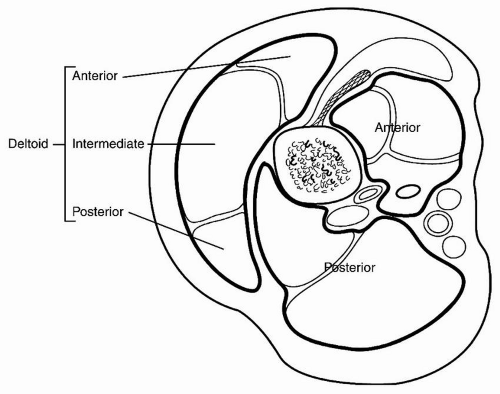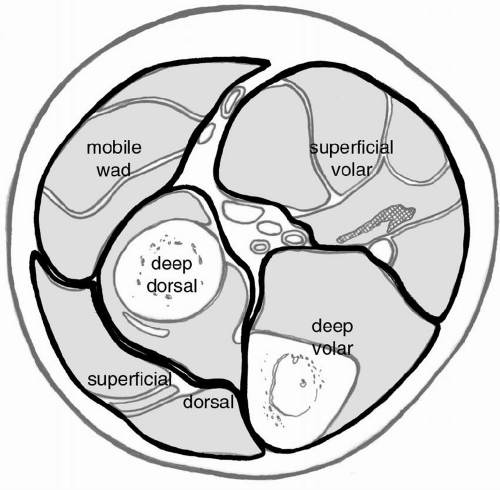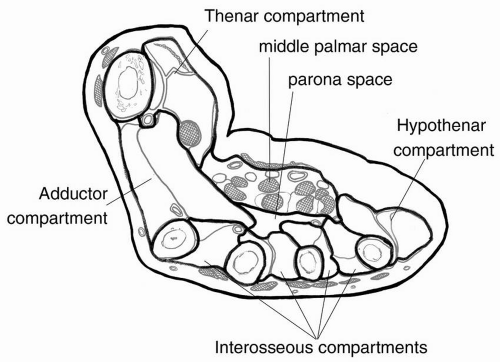Compartment Syndromes
Fraser Leversedge
I. Definition
A condition in which interstitial tissue pressures within an osteofascial compartment are elevated to sustained, nonphysiologic pressures.
Compartment syndrome may be considered as incipient, acute, late (delayed diagnosis), chronic/exertional, or from extrinsic compression such as from a constricting cast or splint.
II. Pathophysiology
In general, increasing pressure within a confined space will compromise the circulation and function of its contents.
The law of Laplace determines the equilibrium about the vessel wall:
Pi – Po = T/R
where Pi is the pressure inside vessel
Po is the pressure outside vessel
T is the vessel wall tension
R is the radius of vessel
Local blood flow (LBF) is determined by the following equation:
LBF = (Pa – Pv)/R
where Pa is the arterial pressure
Pv is the venous pressure
R is the local vascular resistance
Progressive pathologic alteration in compartmental physiology is described below:
Increased compartment pressure
↓
Venous outflow obstruction
↓
Increased capillary permeability
↓
Increased intracompartmental pressure
↓
Decreased arterial perfusion
↓
Decreased tissue oxygenation
↓
Reversible ischemia
↓
Irreversible ischemia
III. Pertinent Anatomy
Multiple osteofascial compartments have been described for the upper extremity (below); however, subcompartmentalization of these compartments, such as the flexor digitorum profundus within the volar forearm compartment, has been observed clinically.
Brachium/arm (Fig. 27.1)
Deltoid (anterior, middle, and posterior subcompartments)
Anterior compartment
Posterior compartment
Antebrachium/forearm (Fig. 27.2)
Dorsal compartment (superficial & degs)
Volar compartment (superficial & degs)
Mobile wad
Hand (Fig. 27.3)
Carpal tunnel/distal ulnar tunnel
Thenar compartment
Hypothenar compartment
Dorsal and palmar interosseous compartments
Digit
IV. Compartment Syndrome: Etiology
There are many potential etiologies for the condition of compartment syndrome, including
Fracture or soft tissue injury (trauma)
Prolonged limb compression
Arterial injury
Reperfusion injury
Snakebite injury
Electrical burns
Hematologic disorders
Infections
Iatrogenic: excessive tourniquet ischaemia
Limb lengthening
Closure of fascial defects
Constrictive cast/splint/dressing
Complications of intraoperative positioning
Intermittent, exercise induced
Remember: Compartment syndrome can develop in the presence of an open wound.
 Figure 27.1 Cross-sectional illustration demonstrating the compartments of the upper arm. (Reprinted with permission. Copyright 2009: Leversedge FJ, Goldfarb CA, and Boyer MI.) |
 Figure 27.2 Cross-sectional illustration demonstrating the compartments of the forearm. (Reprinted with permission. Copyright 2009: Leversedge FJ, Goldfarb CA, and Boyer MI.) |
V. Diagnostic Considerations
History of injury
Consider both intrinsic (intracompartmental bleeding/swelling) and extrinsic (tight cast or dressing) factors, which may elevate intracompartmental pressures.
External compression, such as from a constricting cast or splint, can contribute to the elevation of intracompartmental pressure.
Clinical evaluation
Compartment syndrome, or an incipient condition, is primarily a clinical diagnosis although objective testing may be confirmatory.
Six “P”s are considered in the diagnostic evaluation of compartment syndrome:
Pain with passive stretch
Increased pressure of the affected compartment on palpation
Stay updated, free articles. Join our Telegram channel

Full access? Get Clinical Tree







